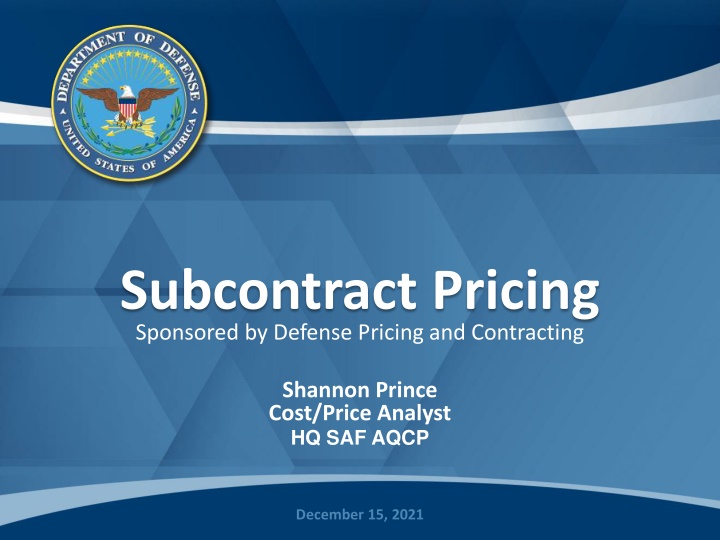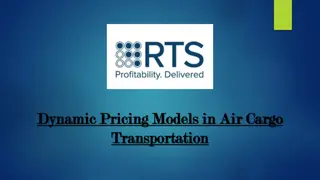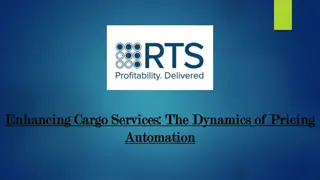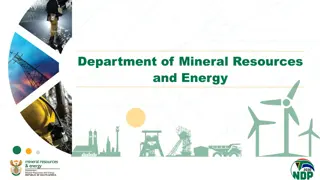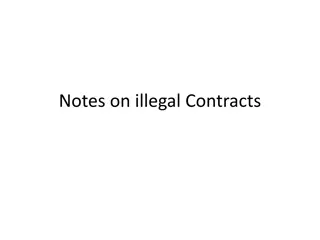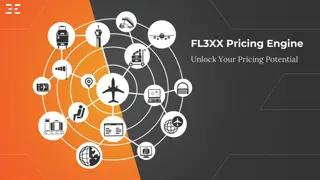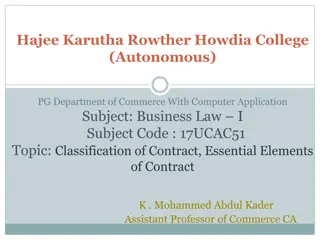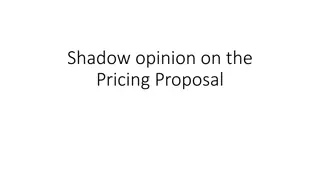Subcontract Pricing in Government Contracts
Explore the importance of subcontracting in defense contracts, including subcontract definitions, thresholds, prime contractor expectations, types of subcontracts, and hot topics in pricing analysis. Learn about FAR regulations, consent to subcontracts, and pricing negotiations in subcontracting arrangements.
Download Presentation

Please find below an Image/Link to download the presentation.
The content on the website is provided AS IS for your information and personal use only. It may not be sold, licensed, or shared on other websites without obtaining consent from the author.If you encounter any issues during the download, it is possible that the publisher has removed the file from their server.
You are allowed to download the files provided on this website for personal or commercial use, subject to the condition that they are used lawfully. All files are the property of their respective owners.
The content on the website is provided AS IS for your information and personal use only. It may not be sold, licensed, or shared on other websites without obtaining consent from the author.
E N D
Presentation Transcript
Subcontract Pricing Sponsored by Defense Pricing and Contracting Shannon Prince Cost/Price Analyst HQ SAF AQCP December 15, 2021
Why Talk about Subcontracts? The Government Accountability Office (GAO) has reported, Based on some estimates, 60 to 70 percent of work on defense contracts is now done by subcontractors, with certain industries aiming to outsource up to 80 percent of the work. Source: GAO-11-61R 2
Overview Subcontract Definitions Pertinent Thresholds Prime and Contracting Officer (CO) Expectations Subcontract Types Competitive Subcontracts Subcontract Commercial Item Determinations (CIDs) Sole Source Commercial Subcontracts Price Analysis Sole Source Subcontracts Cost Analysis Subcontracts below TINA Threshold Price Analysis Hot Topics: Early Engagement, Consent to Subcontract, Actuals, Long-Term Agreements (LTAs), Field Pricing Assistance, Excessive Pass-Through Costs, Inter- Organizational Transfers 3 Summary
Subcontract Definitions FAR Part 44 Definition - Any contract entered into by a subcontractor to furnish supplies or services for performance of a prime contract or a subcontract Includes but is not limited to purchase orders, and changes and modifications to purchase orders Prescribes policies and procedures for consent to subcontracts or advance notification of subcontracts, and for review, evaluation, and approval of contractors purchasing systems 4
Subcontract Definitions (contd) FAR Subpart 15.4 Additional definition Subcontract (except as used in 15.407-2) also includes a transfer of commercial items between divisions, subsidiaries, or affiliates of a contractor or a subcontractor Prescribes cost and price negotiation policies and procedures for pricing negotiated prime contracts (including subcontracts) and contract modifications 5
Pertinent Thresholds TINA Threshold: $2,000,000 or greater Subcontractor shall submit certified cost or pricing data to the prime (subject to TINA) unless an exception applies (FAR 15.403-1) Adequate price competition Commercial items TINA Waivers (heavily restricted) Prices set by law or regulation Modifying a contract/subcontract for commercial items Threshold applies to all tiers of subcontracts as long as the higher tier subcontract does not meet a TINA exception 6
Pertinent Thresholds (contd ) FAR threshold for submission of subcontractor data to Government as part of the prime s certified cost or pricing data is $15M or $2M and 10% of prime proposal price (FAR 15.404-3(c)(1)) Prime must submit sub s cost or pricing data to the government (unless determined unnecessary by the CO) If the sub will not provide proprietary data to the prime (e.g., competitors) they have the option to send the data directly to the CO Government also has right to obtain sub s data below the threshold when determined necessary by the CO 7
Government Expectations of Prime Contractor Act as agent of Government contract with responsible sources and award subcontracts at reasonable prices Select subcontractors & suppliers on a competitive basis to the maximum practical extent consistent with objectives and requirements of the contract (52.244-5, Competition in Subcontracting) Just as we are expected to conduct competitions, so is the prime Sole source at the prime level does not automatically translate to sole source at the subcontract level, especially for commercial products/services Incorporate commercial products/services to maximum extent practicable (FAR 44.402(a)(1)) 8
Government Expectations of Prime Contractor (cont d) Comply with TINA, obtain certified cost or pricing data and certificates of current cost or pricing data from subcontractors when required, and flow down required clauses to subcontractors (FAR 52.215-12 and -13) Follow it s own internal procedures All major contractors have procedures in place that are reviewed by DCAA and DCMA with respect to subcontracts Collaborate with COs on major suppliers as needed Conduct appropriate cost or price analyses to establish reasonableness of proposed subcontract prices (FAR 15.404-3(b) and Table 15-2) Conduct cost analysis for all subcontracts when certified cost or pricing data are submitted by the subcontractor (FAR Table 15-2) 9
Government Expectations of Prime Contractor (cont d) Conduct appropriate cost or price analyses to establish reasonableness of proposed subcontract prices (cont d) Conduct price analysis of all subcontractor proposals (FAR Table 15-2) Proposal Expectations Include results of analysis with price proposal (FAR 15.404-3(b)(2), Table 15-2, 52.215-20/-21, DFARS 252.215-7010, and DoD Proposal Adequacy Checklist (PAC) Item #17) If not provided at time of proposal submittal, prime should provide schedule for completion Identify subcontract proposals for which CO has initiated or may need to request field pricing analysis (DoD PAC Item #15) Provide subcontractor certified cost or pricing data when required (see thresholds & DoD PAC Item 16) Submit basis for commercial item exceptions (DoD PAC #18) 10
Government Expectations of Prime Contractor (cont d) Proposal Expectations (cont d) Support degree of competition and basis for price reasonableness for items over threshold for certified cost or pricing data (Table 15-2 Section II(A)(1) and DoD PAC #20) Submit cost proposals for Inter-organizational transfers proposed at cost in the format given in Table 15-2 Section II(A)(2) (DoD PAC #21) Submit an analysis supporting exception from certified cost or pricing data for inter-organizational transfers proposed at price (Table 15-2 Section II(A) and DoD PAC #22) Provide required information from 52.215-22 and DoD PAC #36 when planning to subcontract more than 70% of cost of work to be performed 11
CO Expectations CO is responsible for the determination of a fair and reasonable price for the prime contract, including subcontracting costs (FAR 15.404-3) FAR directs CO to consider status of purchasing systems, prime analyses of subcontract proposals, and whether subcontract prices have been negotiated, but this does not relieve CO from responsibility to analyze subcontractor s cost or pricing data Engage early to help prime avoid bad subcontract deals with major suppliers May include collaborative engagement with all stakeholders (Prime, DCMA, DCAA, etc.) to assist (as appropriate) in evaluating and potentially participating in prime/sub negotiations This may occur prior to receipt of subcontractor s proposal or even before subcontractor RFP release 12
CO Expectations (contd) Understand extent they can rely on prime s ability to evaluate and negotiate fair and reasonable subcontract prices and whether field assistance is needed risk can be increased by Disapproved purchasing and/or estimating systems at prime or subcontractor level Presence of large-dollar suppliers either as an overall value or in relation to overall contract and establishment of long-term subcontracts (not already reviewed) Sole source subcontracted items versus competed subcontracts Supplier s refusal to provide data to prime, bad subcontract deals, or actuals do not support negotiated prices Lack of arm s-length relationship between contractor and subcontractor 13
CO Expectations (contd) Review subcontract data as needed, e.g., major supplier proposals Assist prime in fact-finding/negotiations with major suppliers when mutually agreed to Review prime cost and price evaluations, especially for major suppliers, and consider adequacy when completing DoD Weighted Guidelines, management/cost control factor Concept of Materiality is addressed in Sole Source Streamlining ToolBox 14
CO Expectations (contd) Hold prime accountable to schedule for completion of subcontract analyses Sole Source Streamlining Toolbox includes a Subcontract Proposal Tracking Matrix that can be used to monitor schedule Report concerns about adequacy of prime contract analyses, failure to complete analyses, or untimely analysis to DCMA The ACO will want to take this information into consideration when assessing the contractor s purchasing system and estimating system Evaluate Inter-organizational Transfers similarly to prime s proposal, since this is not an arm s-length relationship (can t rely on the prime s analysis of a sister division) 15
Subcontract Type Prime is responsible for determining contract type at subcontract level For prime FFP contracts, the prime will typically flow FFP down to the supplier level This makes sense since the primes would not want to take on the risk of subcontract overruns, and the overall buy meets the parameters to be FFP For prime cost-type contracts, it is also not uncommon for there to be a lot of FFP subcontracts, especially at the smaller dollar level However, it is important for the prime to recognize what is driving the cost-type nature of the prime contract Alternatives to FFP may be appropriate for risky large- dollar subcontracted efforts 16
Subcontract Type (contd) There may be times when the CO needs to engage with the prime on subcontract type Example: FPIF prime whereby CO learned that major supplier s actual cost varied widely from what was negotiated; CO influences subsequent subcontract buy to be FPIF 17
Competitive Subcontracts Competition at the subcontract level is vital for purposes of avoiding data denials and overpriced parts Competed subcontracts facilitate agreement on reasonableness of subcontract pricing, and reduce the subcontract analysis burden for both parties Acquisition teams should encourage prime contractors to compete subcontracts whenever possible In follow-on acquisitions this discussion can begin well in advance of RFP issuance This would be important to explore if the prime has determined a subcontract requirement to be commercial Must conduct price analysis to determine the competed price is fair and reasonable Comparing prices received in response to a solicitation is a preferred form of price analysis 18
Competitive Subcontracts (contd) Prime role in subcontract competitions Per Table 15-2, prime shall Provide data showing the degree of competition and the basis for establishing the source and reasonableness of price for those acquisitions Prime should follow its own procedures, which would normally include documentation of subcontract competitions Example: Describes evaluation criteria, lists offers that were received, supports presence of adequate price competition, and in case of best value, describes the tradeoffs that were made 19
Competitive Subcontracts (contd) CO role Review prime documentation when appropriate, e.g., competition of major suppliers For competitions based on trade-offs among cost or price and other non-cost factors rather than lowest price, prime analysis should include discussion of factors considered in analysis If prime analysis is inadequate, CO should return for correction of deficiencies (DFARS PGI 215.404-3(a)(v)) CO can challenge the prices obtained through competition if the prime ultimately did not demonstrate adequate price competition Example: one offeror responded, incumbent subcontractor was not solicited, and price went up 20% May serve as advisor to prime for purpose of developing subcontract solicitation DCMA/DCAA may be able to help 20
Subcontract Commercial Item Determinations (CIDs) Responsibilities DFARS 244.402 Policy requirements (a) Contractors are required to determine whether a particular subcontract item meets the definition of a commercial item. This requirement does not affect the contracting officer s responsibilities or determinations made under FAR 15.403-1(c)(3). Contractors are expected to exercise reasonable business judgment in making such determinations, consistent with the guidelines for conducting market research in FAR Part 10. Prime should follow its established practices for commercial item determinations 21
Subcontract Commercial Item Determinations (cont d) CO Reliance on Prime CIDs Under DFARS 244.402, it is the prime s responsibility to determine whether a subcontract item meets the commercial Item definition If the prime does due diligence in making a commercial item determination you should be able to rely on prime CID Unless they are in error, without foundation, or are in direct conflict with existing government acquisitions which are treating the same item as other than commercial In order to achieve consistency within the DoD, it is important for the prime s CID to be consistent with how the primary government buying activity the expert procures that item 22
Subcontract Commercial Item Determinations (cont d) CO Reliance on Prime CIDs (cont d) Since commercial items require a written determination by the CO for acquisitions over $1M (DFARS 212.102(a)(i)(A), it is a reasonable expectation for contractors to follow suit in order for the CO to rely on their determination (and understand the basis for it) Companies should follow their own procedures for CIDs, including for documentation For history on the commerciality of an item the PCO can check the Commercial Item Database and with the DCMA Commercial Items Group (CIG) Not relying on a prime s CID does not require leadership approval, but keep your leadership well informed However, if you are not relying on a prime s CID that was based on a prior PCO CID, you must get Head of the Contracting Activity (HCA) approval In the exceptional event you do not rely on a prime s CID Helpful to notify the DCMA CIG for purpose of consistency across DoD If the buy does not meet a TINA exception, e.g. Adequate Price Competition, you will need to work with the prime to obtain a TINA compliant proposal 23
Sole Source Commercial Subcontracts Price Analysis This area can be challenging, especially in situations where sole source suppliers refuse to share information with prime Prime s role Follow its own procedures, including for documentation Utilize the principles in Subpart 15.4 for price analysis When comparing proposed prices to historical prices paid Prior price must be valid basis for comparison, considering time lapses, differing Terms and Conditions (Ts&Cs), or uncertainty of reasonableness of prior price Adjust prior price to account for materially differing terms & conditions, quantities, and market and economic factors and adjust for material differences for similar items Use expert technical advice when accomplishing comparisons to similar items or analyzing commercial items that are of a type or require minor modifications, to ascertain the magnitude of changes required and to assist in pricing the required changes DoD has proposed amending DFARS to implement Section 803 of the FY2020 NDAA which prohibits contracting officers from determining the price of a contract or subcontract as fair and reasonable based solely on historical prices paid by the Government 24
Sole Source Commercial Subcontracts Price Analysis (cont d) Prime s role (cont d) Obtain minimum necessary data to conduct price analysis Required by DFARS 252.215-7010 (Jul 2019) to insert the substance of the provision in subcontracts exceeding the simplified acquisition threshold and require prospective subcontractors to adhere to requirements for data other than certified cost or pricing data in paragraph (d) Requires minimum information necessary to permit a determination the proposed price is fair and reasonable, to include DFARS 215.402(a)(i) and 215.404-1(b) When data is uncertified, it shall be provided in the form in which it is regularly maintained by the subcontractor in its business operations Requires subcontractors to provide data within 10 days of request or explanation of inability to comply Prime may not require cost data from prospective subcontractors when there are sufficient non-Government sales of same item to establish reasonableness If relying on sales data for similar items, only obtain technical information necessary to support conclusion items are technically similar and explain differences accounting for variances in price 25
Sole Source Commercial Subcontracts Price Analysis (cont d) Prime s role (cont d) Understand DFARS 215.404-1(b), which provides hierarchy for obtaining data In the absence of adequate price competition, pricing based on market prices is the DoD s preferred method to establish a fair and reasonable price If market research is insufficient, prices paid for similar items under comparable Ts&Cs by both Government and commercial customers is next If that is insufficient, the next step is to obtain information on prices paid For same/similar items under different Ts&Cs; For similar levels of work or effort on related products or services; For alternative solutions or approaches; and Other relevant information that can serve as basis for price reasonableness If that is insufficient, then other relevant information (including uncertified cost data) can be requested No cost data may be required when there are sufficient non-government sales 26
Sole Source Commercial Subcontracts Price Analysis (cont d) Prime s role (cont d) Understand 215.404-1(b)(v) factors that affect relevance of available information Market Prices Current prices that are established in the course of ordinary trade between buyers and sellers free to bargain and that can be substantiated through competition or from sources independent of the offerors Age of data depends on industry, product maturity, economic factors Volume and completeness of transaction data relevant sales to all types of customers and includes key information such as date, quantity, price, customer, etc. Nature of transactions info necessary to understand transaction such as terms and conditions, type of customer, preferred customer rewards, etc. Alert CO when subcontractor is refusing to provide data 27
Sole Source Commercial Subcontracts Price Analysis (cont d) CO role Assist the prime in making requests to the DCMA Commercial Item Group (CIG) when appropriate Review commercial price analyses, especially large dollar Expect prime to conduct market research and obtain data when necessary Prime analysis based exclusively on prior sole source awarded commercial subcontracts may need extra scrutiny FY2020 NDAA, Section 803 prohibits COs from determining the price of a contract or subcontract as fair and reasonable based solely on historical prices paid by the Government. This has yet to be incorporated into DFARS (DFARS draft proposed rule 2020-D008) On occasion, may be the recipient of proprietary data a subcontractor refuses to provide the prime Provide results of any government evaluation to prime for purpose of incorporating into analysis or negotiations (depending on timing) Remember the pricing challenges of sole source commercial item subcontract acquisitions will go away if the prime competes the commercial items 28
Sole Source Subcontracts Cost Analysis Primes must follow their internal procedures, including for documentation Primes shall obtain certified cost or pricing data from subcontractors who do not qualify for a TINA exception Obtain as instructed in DFARS 252.215-7010, Requirements for Certified Cost or Pricing Data and Data Other Than Certified Cost or Pricing Data (Jul 2019) Requires contractors to insert substance of provision in subcontracts exceeding the simplified acquisition threshold and requires prospective subcontractors to adhere to requirements for providing certified cost or pricing data in paragraph (c) Paragraph (c) references Table 15-2 for purpose of submission of cost or pricing data Primes may elect to have subcontractors use DoD PAC or a similar checklist 29
Sole Source Subcontracts Cost Analysis (cont d) Prime required to conduct cost analysis of subcontract proposals when certified cost or pricing data are required Cost analysis is the analysis of individual cost elements and profit Labor Hours CO may have internal technical personnel or DCMA review prime technical analysis CO should ensure government findings were incorporated into prime analysis or negotiated settlement (depending on timing) For recurring buys, actuals are necessary to conduct an informed evaluation Rates In most cases, subcontractors will not share rate information with the prime, and the prime will need DCMA or DCAA assistance The CO may have to provide the impact of differences in rates to the prime for purpose of evaluation/negotiations cannot reveal proprietary information (DFARS PGI 215.404-3(a)(iii) 30
Sole Source Subcontracts Cost Analysis (cont d) Material & Other Direct Costs Prime should obtain assistance from DCAA/DCMA when needed, especially for audits on major suppliers CO should ensure government findings are incorporated into prime analysis or negotiated settlement (depending on timing) Prime should be ensuring subcontractors are performing required analysis on lower-tiered subcontractors Profit COs may encourage contractor to use WGL; it is common for large companies to use that approach COs evaluate whether the end result seems reasonable rather than try and obtain agreement on individual weights/factors COs ensure fee limitations in FAR 15.404-4(c)(4)(i) not exceeded COs ensure subcontract is not on the basis of cost-plus-a- percentage-of-cost 31
Sole Source Subcontracts Cost Analysis (cont d) Terms & Conditions Prime is responsible for negotiations CO should evaluate significant terms and conditions that have impacts to pricing or payment, such as price breaks from combining purchases Should review total cost actuals for the top 3-5 subcontractors that do not meet a TINA exception and compare to previously negotiated cost lines Prime should also conduct price analysis on buys requiring certified cost or pricing data Important to ensure prices are not rising at unacceptable levels Purpose of the cost analysis is to assist in prime/subcontract negotiations to obtain a fair and reasonable price 32
Subcontracts below TINA Threshold Price Analysis Price analysis is the process of examining the price without evaluating separate cost elements and profit (FAR 15.404-1(b)) Prime is responsible for conducting price analysis when certified cost or pricing data are not required and is required to submit the results of the analysis to the Government Methods of Price Analysis Comparing prices received in response to a solicitation is a preferred form of price analysis (competitive buys) Comparison of proposed prices to historical prices paid for same or similar items (prior price must be valid basis and must be normalized) 33
Subcontracts below TINA Threshold Price Analysis (cont d) Methods of Price Analysis (cont d) Parametrics to highlight significant inconsistencies that warrant additional pricing inquiry Comparison with competitive published price lists, published market prices of commodities, similar indexes, and discount or rebate arrangements Comparison of proposed prices with independent Government cost estimates Comparison of proposed prices with prices obtained through market research for the same or similar items Analysis of data other than certified cost or pricing data provided by the offeror 34
Subcontracts below TINA Threshold Price Analysis (cont d) For more complex, higher-dollar efforts less time would typically be spent on analyzing these costs This is true unless they are suppliers that have been historically problematic with respect to their pricing practices In those situations they would need to be evaluated in all circumstances regardless of complexity or dollar value. For all others consider the following evaluation approaches Review the prime s evaluation on the sub and if acceptable, rely on it If applicable, rely on evaluation performed by DCMA/DCAA Apply decrements when necessary based on techniques such as: Utilization of resulting decrement from detailed evaluation of large dollar subcontractors The prime contractor s negotiation history Sampling of lower risk/lower dollar subcontractors Knowledge gained from previous efforts 35
Subcontracts below TINA Threshold Price Analysis (cont d) For less complex, lower dollar efforts more time would typically be spent on analyzing these costs CO should review the basis of the proposed cost and review the prime s price analysis of it Consider the following evaluation approaches If the CO can determine that the prime s price analysis results in a fair and reasonable price, they should be able to rely on it Apply decrements when necessary based on data gathered during comparison of proposed costs with: Updated quotes from the subcontractor Historical prices paid that have been normalized (DoD has proposed amending DFARS to implement Section 803 of the FY2020 NDAA which prohibits the use of this as the sole technique applied) Prices obtained through market research Published competitive price lists or published indexes Other than certified cost or pricing data provided by the subcontractor 36
Hot Topics Early Engagement Consent to Subcontract Actuals Long Term Agreements (LTAs) Field Pricing Assistance Excessive Pass-Through Costs Inter-Organizational Transfers 37
Early Engagement Purpose of early engagement is to save time on schedule and avoid problems down the road Requires cooperation between government and contractor CO can identify potential problem areas based on previous experience Lessons learned from previous Contracting Officers and Price Analysts Common concerns may include: Subcontract proposal adequacy Subcontract refusal to provide actuals and other relevant data Adequacy of prime cost and price analyses Failure of prime to consider/incorporate government findings 38
Early Engagement (contd) CO should include DCMA and DCAA as early as possible to ensure buy-in and facilitate future audits and reviews CO should consider release of a draft RFP to prime to jumpstart the process Collaborate with Prime on major subcontracts prior to subcontract RFP release Establish ground rules up front for Government engagement with subcontractors Consider codifying the arrangement via MOU with prime DoD Sole Source Streamlining Toolbox provides early engagement techniques in sections 1, 2 and 3 39
Early Engagement (contd) Collaborate with Prime on major subcontracts prior to subcontract RFP release (cont d) Include ways to streamline subcontract proposal analysis Require submission of working cost models Require submission of subcontract actuals for appropriate subcontract RFPs Influence contract type selection for subcontracts when appropriate Facilitate improvements to subcontractor proposal adequacy Consider attending the prime s subcontract kickoff Communicate Government expectations Be available to answer questions 40
Early Engagement (contd) Collaborate with Prime on major subcontract evaluation after subcontract proposal receipt Consider conducting subcontract fact-finding in tandem with the prime Ensures appropriate questions are being asked May help avoid an inadequate Cost Analysis Report (CAR) or Price Analysis Report (PAR) Provide rate impacts and other information as needed to prime When necessary, help facilitate negotiations between prime and subcontractor to ensure a fair and reasonable subcontract price 41
Consent to Subcontract What is it? Contracting Officer s written consent for the Contractor to enter into a particular subcontract Normally consent is granted by the ACO unless it is retained by the CO Unless specified in the consent, CO s consent to subcontract does not constitute determination of the acceptability of the subcontract terms or price or the allowability of costs When is it required? For contractors without an approved purchasing system Cost-Reimbursement (CR), Time & Materials (T&M), Labor Hour, Letter Contracts For unpriced actions under fixed-price contracts that exceed SAT for CR, T&M or Labor Hour subcontracts; and Fixed-price subcontracts that exceed the greater of SAT or 5% of the total estimated cost of the contract 42
Consent to Subcontract (contd) When is it optional? For contractors with an approved purchasing system Any subcontracts specifically identified by the CO in paragraph (d) of FAR Clause 52.244-2 When should we consider it? Under UCAs, contractors may not be incentivized to control costs prior to definitization Government typically accepts incurred costs, unless unallowable Avoid situations where CO does not agree with negotiated deals Must fill in the specific subcontractors names into the Subcontracts clause 43
Consent to Subcontract (contd) When should we consider it? (cont d) Contracts where CO considers Government to have risk for overpaying post contract award Example might be a cost-type contract whereby major subcontract analyses were not completed prior to contract award Must fill in the specific subcontractors names in the Subcontracts clause 44
Actuals Should be requested by the prime for the top 3-5 subcontracts as certified cost or pricing data when an item or service has been previously procured from the same subcontractor Applicable only to subcontracts subject to TINA Encourage prime to include request for actuals in the subcontractor RFP and at a level that is most relevant to reduce administrative burden. Examples include, Total subcontract level Unit cost level Only certain elements such as total recurring engineering hours 45
Actuals (contd) Government team should not be requesting information on subcontractor profitability The expectation is that the cost information will be compared to historical considered negotiated cost to assess accuracy of cost estimates Recommend providing instructions regarding format so that the data is usable and easily understood once submitted Suggested language can be found at AFFARS MP5315.4- 1.d 46
Actuals (contd) Actuals may need to be normalized to account for: Differences in quantity Contract length Work scope Date that actuals were incurred Partially completed items 47
Long-Term Agreements Long-term agreements (LTA) are agreements entered into between a prime or higher- tiered contractor and a subcontractor to establish pricing for future purchases of specified items Why LTAs can be beneficial to the Government Can result in more favorable subcontract pricing due to a more stabilized business volume Can reduce acquisition cycle times 48
Long-Term Agreements (contd) LTAs are an acceptable pricing method since FAR allows a prime to reach price agreement with a sub in advance of agreement with the Government Unless an exception to FAR 15.403-1(b) applies, the prime is required to obtain and analyze certified cost or pricing data before awarding any subcontract regardless of how far in advance a price agreement is reached Contractors do not generally have to obtain updated cost or pricing data when proposed subcontract costs are based on existing LTAs Expired LTAs do require updated cost or pricing data Older LTAs should have some level of review to ensure prices are still reasonable 49
Long-Term Agreements (contd) Program Offices should encourage early DCAA involvement in the review of LTAs prior to the prime negotiating with the subcontractor DCAA can perform an examination of a subcontractor proposal, submitted to support the award of a Long Term Agreement (LTA), prior to issuance of a Government Request for Proposal when such an examination will benefit the Government and is requested by the Contracting Officer. (15 Feb 18 DCAA Audit Alert) 50
